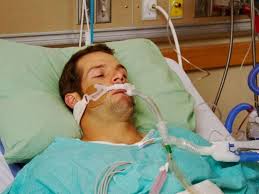 Technique for the respiratory care of many critically ill patients who require ventilatory support.
Technique for the respiratory care of many critically ill patients who require ventilatory support.
The baseline end-expiratory pressure in mechanically ventilated patients is elevated above atmospheric pressure.
Its application expected to improve lung mechanics and gas exchange as it recruits lung volume.
It is not clear how much PEEP is required in the ventilatory management of patients with acute respiratory failure.
It is used at the lowest level that maintains an adequate arterial partial pressure of oxygen on an inspiratory fraction of oxygen less than 60%.
In most instances it is applied at a median level of 8 cm H2O, there by reducing dynamic stress and strain.
Negative physiological effects include decreased cardiac output decreased venous return, increased intracranial pressure, barotrauma, and hypotension.
Has possible adverse effects on the function of the right and left ventricles, pulmonary vascular resistance and thoracic compliance with alteration of gas exchange and hemodynamics.
PEEP can be harmful; as it necessarily increases mean airway pressure and alveolar pressure, which can damage normal alveoli by overdistension resulting in diffuse alveolar damage.
The net benefit or harm from PEEP depends on the balance of alveolar recruitment to overdistention and should be beneficial indisease states with a substantial alveolar collapse, such as ARDS.
Although PEEP can indirectly act as assistance to ventilation through various mechanisms: counterbalancing the mechanical load imposed by residual end-expiratory alveolar pressure in COPD exacerbations, combating atelectasis providing a mechanical stent of the upper airways or acting as a threshold external pressure to overcome the critical opening pressure of the airway.
In patients with hypoxemia, when impairment of oxygenation is secondary to a loss of aerated alveoli leading to intrapulmonary shunt, PEEP may facilitate alveolar recruitment, thus improving arterial oxygenation.
When PEEP is applied to improve oxygenation, it is important to clinically estimate its effect on the work of breathing.
Excessive PEEP can induce hyperinflation and reduce the efficiency of diaphragmatic contraction.
In cases of left ventricular dysfunction, PEEP may have beneficial effects by increasing the intrathoracic pressure and thus decreasing preload, as well as by reducing the work of breathing.
By decreasing the negative intrathoracic pressure swings generated by the activity of the respiratory muscles, PEEP decreases the afterload on the left ventricle.
These effects are negligible in the context of normal cardiac func-tion, but PEEP in the form of CPAP or noninvasive ventilation can be very effective in relieving respiratory distress in patients with cardiogenic pulmonary edema by improving both cardiac and respiratory function.
